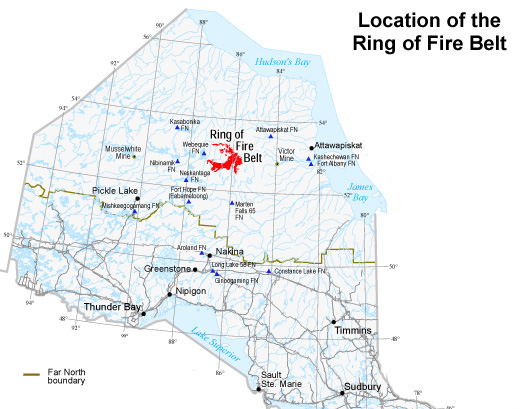By Kerrie Blaise and Brady Reid
This article was originally published by The Lawyer's Daily (www.thelawyersdaily.ca), a division of LexisNexis Canada.
In response to Ontario’s mad dash to develop the controversial Ring of Fire (ROF) mineral cache in Ontario’s Far North, First Nation communities across Ontario’s Far North have reminded the province of constitutionally protected Indigenous and treaty rights and the Crown’s duty to consult.
While 2020 may have begun with a record-setting start for the global mining sector, the onset of the COVID-19 pandemic stalled the demand for raw materials. Subsequently, there has also been a shift in industry and investor priorities and a readjustment of government policy on mining. In this article, we question Ontario’s response to mining developments in light of the COVID-19 pandemic, which has included new policies favouring extractive industry interests over at-risk communities.
What we find is a continued failure by the province to respect calls by legal experts, First Nation communities and Indigenous and environmental organizations to halt permitting and development planning within the Ring of Fire in light of the surmounting difficulties in participation and the exacerbated, pre-existing crises precipitated by the COVID-19 pandemic.
Beginning in March 2020, citing the anticipated hardships that mining companies may undergo due to the COVID-19 pandemic, Ontario’s Ministry of Energy, Northern Development and Mines published the Extension of Time Policy and the Exclusion of Time Policy. These policies are directly at odds with Ontario’s Ministry of Indigenous Affairs that had advised projects potentially affecting treaty rights to be deferred. For example, the Exclusion of Time Policy states:
“Under subsection 67(4) of the Act, the Minister may make an order for an exclusion of time, if the Minister is satisfied that special circumstances exist, which prevented the claim holder from performing and/or reporting work on a mining claim.”
This provision allows junior or even elite mining companies to file a request for the minister to set a new renewal date for the claim holder to complete the necessary activities required to keep a claim active. At face value this may not appear to impact the constitutionally protected s. 35 rights of Indigenous peoples, however this policy also includes a provision for claim holders to request an exclusion of time, notably:
“In very exceptional circumstances, the Minister may make an order excluding a period of time if the claim holder has not submitted an exploration plan or an exploration permit application. The decision to make an order under these conditions will be determined by the Minister on a case by case basis in extremely rare situations, where following the exploration plan and exploration permit process would have serious negative repercussions.”
Exploration plans and permits are mechanisms regulated by Ontario’s Mining Act designed to engage Indigenous communities who may face potential negative impacts from nearby mineral exploration activities such as mechanized drilling, line cutting or geophysical surveys — activities related to keeping a mining claim active and in good standing in Ontario. With this newly implemented policy and specific provisions favouring industry interests, Indigenous communities across Ontario’s Far North are at a greater risk of inadequate and inconsistent engagement at the early exploration stage of proposed mining developments while mining companies across North America (such as Newmont and Torex Gold) are reporting record-breaking profits during the third quarter of 2020.
Despite the COVID-19 pandemic, prospecting and early exploration activities have continued within Ontario’s mining sector, with these additional extensions and exclusions announced in Ontario. For instance, Noront Resources Ltd., a Canadian-based mining company, holds 85 per cent of all mining claims in the ROF region — an amount comparable to the entire Sudbury basin (approximately 60 kilometres by 30 kilometres). In October 2020, seven months into a global pandemic, Ontario’s Ministry of Energy, Northern Development and Mines posted six proposals for early exploration permits for Noront and four others for claims also located in the ROF. Figure 1 indicates the approximate location of these proposals. As set out in the proposals, the proponents sought permission to undertake:
- mechanized drilling (where the drill weight is greater than 150 kilograms) which requires clearing surface terrain for drill pads and pumping water from nearby lakes, rivers or streams;
- line cutting (less than 1.5 metres in width) where an individual walks through the bush cutting a corridor (less than 1.5 metres in width) using hand tools (chainsaw, axe or machete);
- geophysical surveys often requires the use of generators to operate the equipment and ground surveys such as induced polarization surveys that involve laying out kilometres of thin wire and placing small metal rods into the ground that are removed from the site once finished.
There is an assumption that mineral exploration activities are low-impact activities and pose low risk to the environment, but this premise remains untested.
While these early exploration permit proposals were posted for a 30-day comment period via the Environmental Registry, in which the public and Indigenous communities could comment on any potential impacts, some commenters including the Friends of the Attawapiskat River and the Canadian Environmental Law Association argued that the process ought to have been paused and comments not time barred, in recognition of the COVID-19 pandemic and the extenuating situation and additional stress put on First Nations in Ontario’s Far North that may hinder their ability to meaningfully engage in the process and provide comment.
At the time of writing of this article, the comment period for these proposals from Noront had closed. However, another suite of proposals to issue early exploration permits has since been posted on the Environmental Registry, with comments being invited until Dec. 30. Together, the proposed mining permits and the approximate 2,000 mining claims they represent, pose a high likelihood of cumulative impacts to the boreal, James Bay Lowlands region.
Again, environmental and Indigenous organizations have responded, noting the posting of these additional exploration permits illustrates Ontario is not listening to calls by affected First Nation communities to halt Ring of Fire decision making. These permits, if approved, would also open up exploration activities in what is the second largest peatland complex in the world, and home for nearly 40,000 Indigenous people across 35 communities whose food, medicine, cultural and sacred spaces for traditional practices and ceremony are sustained by the area’s extensive river networks and wildlife habitats.
Ontario must re-evaluate its priorities as the global health crisis persists to provide support, capacity funding, flexibility and decision-making authority to First Nation communities engaging in proposed development instead of favouring private, industry interests. Anything less will not advance reconciliation and will undoubtedly result in inadequate consultation contrary to the Crown’s constitutional duty.
Kerrie Blaise is northern legal counsel at the Canadian Environmental Law Association. Brady Reid is an emerging settler-scholar identifying with mixed English/Mi’kmaw heritage. At the University of Guelph, his PhD research explores potential impacts of proposed mining in Treaty 9 territory of Northern Ontario.


